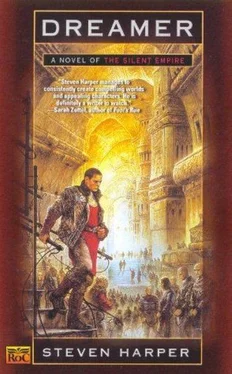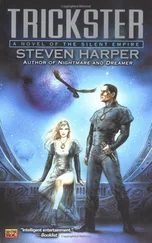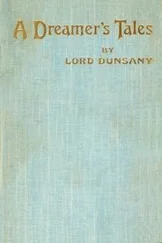Steven Harper - Dreamer
Здесь есть возможность читать онлайн «Steven Harper - Dreamer» весь текст электронной книги совершенно бесплатно (целиком полную версию без сокращений). В некоторых случаях можно слушать аудио, скачать через торрент в формате fb2 и присутствует краткое содержание. Жанр: Фантастика и фэнтези, на английском языке. Описание произведения, (предисловие) а так же отзывы посетителей доступны на портале библиотеки ЛибКат.
- Название:Dreamer
- Автор:
- Жанр:
- Год:неизвестен
- ISBN:нет данных
- Рейтинг книги:4 / 5. Голосов: 1
-
Избранное:Добавить в избранное
- Отзывы:
-
Ваша оценка:
- 80
- 1
- 2
- 3
- 4
- 5
Dreamer: краткое содержание, описание и аннотация
Предлагаем к чтению аннотацию, описание, краткое содержание или предисловие (зависит от того, что написал сам автор книги «Dreamer»). Если вы не нашли необходимую информацию о книге — напишите в комментариях, мы постараемся отыскать её.
Dreamer — читать онлайн бесплатно полную книгу (весь текст) целиком
Ниже представлен текст книги, разбитый по страницам. Система сохранения места последней прочитанной страницы, позволяет с удобством читать онлайн бесплатно книгу «Dreamer», без необходимости каждый раз заново искать на чём Вы остановились. Поставьте закладку, и сможете в любой момент перейти на страницу, на которой закончили чтение.
Интервал:
Закладка:
Prasad had spent his days cutting and splicing genes, many of them his own. Katsu, meanwhile, spent her time in a small nursery area set up within Prasad’s lab. A slave woman looked after her needs, but Prasad had wanted his daughter nearby.
Several fetuses were already gestating by the time Prasad arrived, and it wasn’t long before the babies were born. Very early, however, it became clear that something was wrong. The subjects didn’t respond to outside stimuli. They rarely moved, and they never, ever cried.
After some study, Dr. Kri came to the conclusion that their brains hadn’t developed quite properly. The subjects were barely as intelligent as a fish or a bird. They were certainly not sentient. He had advocated destroying them and starting over. But Prasad had argued vehemently against it. He knew it was because he looked at the infants, perfectly formed but so very quiet, and in them he saw Katsu, but he argued on scientific grounds. Why destroy them when there was more to learn? Dr. Say had agreed and persuaded Dr. Kri.
Other batches of subjects were removed from the machine wombs, but none of them seemed to be intelligent or self-aware. They spent most of their time with their eyes closed and responded only to intense stimuli, especially pain. On the rare occasions when their eyes opened, they were blank and staring. The experiments continued.
Katsu, meanwhile, grew into a toddler and then a child. To Prasad’s pride, she seemed to be extremely intelligent, though she was also very quiet. She seemed possessed of an odd patience, perfectly happy to while away the hours completely by herself. Oddly, she rarely asked questions about the world outside the research base. Katsu seemed to accept the fact that trips to the surface were difficult and rare.
The moment she was old enough, Prasad ensured she could access the computer networks through a disguised link that the Unity would not notice, and she seized on it with an almost startling hunger. Not a social child to begin with, Katsu became even more withdrawn with the addition of network access to her life, and Prasad had to limit the amount of time she spent there. He also kept an eye on what she did with her computer time, and discovered she had a passion for marine biology. By age eight, she was an authority on Rustic ocean life, or so she appeared to Prasad, who knew next to nothing about the subject. He arranged trips for her on the base’s submersile, a small, tank-like vehicle, so she could collect samples of fish and plant life.
She was also fascinated by the experimental subjects. Although they did little but lie still in their beds on the other side of the plastic barrier, Katsu would watch them for long periods with her unreadable dark eyes. At first Prasad and the others had tried to shoo her back to her play area, but Katsu always drifted back. Eventually Prasad gave up trying. It was either let her look or lock her out of the lab, and he just couldn’t bring himself to leave her completely in someone else’s care.
Prasad did worry about Katsu’s social development. The base had little over a dozen other people in it-Drs. Kri and Say, Prasad, a research virologist named Max Garinn, and eleven slaves who cooked, cleaned, and took care of the research subjects. And Dr. Say avoided Katsu. Prasad had never seen her near his daughter. In any case, none of the people were even close to Katsu’s age, and there was no way to arrange playmates. But Katsu didn’t seem to mind. She spent time with her computer, her fish, and her father. Except for the test subjects, the other people on the base barely seemed to exist for her.
Just before Katsu’s ninth birthday, Prasad and other scientists noticed a change in the lab subjects, the ones from the first batch that Dr. Say had wanted to destroy. At times, they expressed agitation, twitching movement that bordered at convulsion. One day when Prasad was observing, one of them sat up and screamed. Or at least, that was what appeared to happen. The subject opened its mouth wide and had a look of fear on its face, but not a single sound emerged from its throat.
Prasad and the other researchers didn’t know what to make of it. Max Garinn, a tidy, blond man with a long mustache he liked to twirl, was especially fascinated. He offered several theories, none of which sounded plausible. Then Katsu, at her customary place near the barrier, spoke up.
“They’re in the Dream,” she said in her soft voice.
And no matter how much Max Garinn and Prasad urged her, she refused to say more.
Dr. Kri immediately reset the medical sensors to read neural activity among the subjects, something she hadn’t done before because human Silent never showed direct awareness of the Dream without training. She found increased activity in each subject’s right hemisphere, consistent with normal humans in REM sleep and with Silent humans in the Dream. The pons of each subject was also sending a multitude of signals to the thalamus and cerebral cortex, again indicating dream-or Dream-activity.
Excitement reigned in the lab for weeks as the phenomenon was studied. Obviously the early batch of subjects had met with some success-they were able to reach the Dream, and without training. Prasad tried several times to entice Katsu into telling him how she had known, but she continually refused to say.
The same thing happened when the next set of subjects reached their eleventh year, and the next set, and the next. At this point thirty-five subjects were reaching the Dream on a steady basis.
So was Katsu. At age thirteen, two years after the first subjects entered the Dream, she had lain down on her bed and, without help from any drugs Prasad knew about, gone into the Dream herself. She had reported the fact to Prasad at dinner that night in the same tone of voice that she might have used to report the acquisition of a new fish. Astounded, Prasad pressed for details, but Katsu avoided giving them. All she would say was, “They taught me.”
And Prasad had to be content with that.
Dr. Say had wanted Prasad to be more persistent, to the extent of forcing the information from her if necessary, but Prasad couldn’t bring himself to do it. Katsu’s presence in his life was a delicate, fragile thing, something to be honored and cherished. He couldn’t bear to raise his voice in her presence, let alone wring information from her.
As time passed, Katsu spent more and more time in the Dream and less on the computer. Prasad had no idea what she did in the Dream, but she seemed none the worse for the time she spent there. At age seventeen, Katsu was a beautiful, serene young woman. Nothing seemed to bother or even startle her, and Prasad could not imagine her any other way.
And now they wanted her eggs.
Prasad’s genes were conducive to creating Silent subjects, and Dr. Kri had determined that Katsu’s were as well. Not only did she carry both Vidya’s and Prasad’s rich genetic structures, Katsu additionally carried a bonus-Vidya’s mitochondrial DNA. The mitochondria, a tiny cell structure contained that converts sugar into energy, contains a strand of DNA separate from the cell’s nucleus. Mitochondrial DNA, however, is passed down from mother to child. The father contributes nothing to it. This meant that Katu’s mitochondrial DNA was a clone of Vidya’s and that Katsu would pass it on to her children one day. Dr. Say wanted to incorporate just Vidya’s DNA into more test subjects, and this was a way to do it.
On the other side of the barrier, another subject opened its mouth in a silent scream. The phenomenon had begun several months ago, starting with the oldest subjects and appearing to spread to the youngest in a mere matter of days. Their blood pressures skyrocketed during these episodes, and their brainwave activity indicated a seizure reminiscent of epilepsy. Prasad didn’t know what to make of it, though Dr. Say claimed to be working on a theory.
Читать дальшеИнтервал:
Закладка:
Похожие книги на «Dreamer»
Представляем Вашему вниманию похожие книги на «Dreamer» списком для выбора. Мы отобрали схожую по названию и смыслу литературу в надежде предоставить читателям больше вариантов отыскать новые, интересные, ещё непрочитанные произведения.
Обсуждение, отзывы о книге «Dreamer» и просто собственные мнения читателей. Оставьте ваши комментарии, напишите, что Вы думаете о произведении, его смысле или главных героях. Укажите что конкретно понравилось, а что нет, и почему Вы так считаете.












